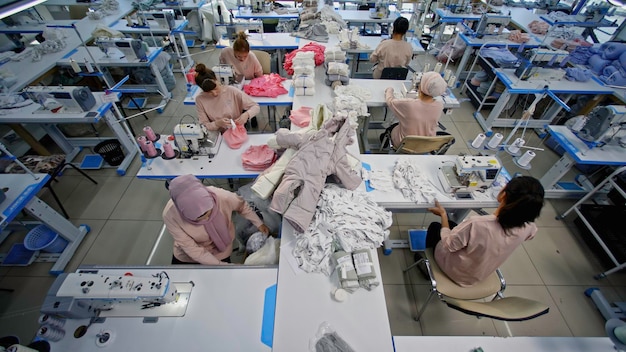From Runway to Reality: Fast Fashion Drops & High-End Replicas

Fast fashion brands are rapidly replicating high-end fashion drops, compressing design-to-retail timelines to under three weeks, impacting trends, consumer behavior, and the fashion industry’s sustainability.
The fashion world moves fast, but the speed at which fast fashion brands are replicating high-end fashion drops in under 3 weeks is truly remarkable. This rapid turnaround has profound implications for the industry, from trend cycles to consumer behavior.
The Accelerated Pace of Fashion Replication
The fashion industry has always drawn inspiration from high-end designs, but the speed at which this inspiration is translated into accessible clothing has changed dramatically. Let’s explore the key drivers behind this accelerated pace of fashion replication.
Technological Advancements in Design and Production
Advanced design software and automated manufacturing processes allow fast fashion brands to quickly interpret and replicate complex designs.
Streamlined Supply Chains
Efficient global supply chains enable rapid sourcing of materials and swift production, reducing the time from concept to consumer.
- Real-time data analysis allows for quick identification of trending styles and immediate production adjustments.
- Advanced pattern-making software expedites the creation of accurate replicas.
- Automated cutting and sewing technologies further accelerate production.
The industry’s embrace of digital tools across design, manufacturing, and logistics has facilitated a significant increase in the speed of fashion replication and quick fast fashion brands are replicating high-end fashion drops in under 3 weeks.

Impact on Trend Cycles
The rapid replication of high-end fashion drops by fast fashion brands is reshaping trend cycles, making them shorter and more volatile. Here’s how:
Reduced Trend Lifespans
The accelerated pace of replication floods the market with similar styles, causing trends to burn out more quickly.
Increased Consumer Demand for Novelty
Consumers constantly crave new styles, leading to a cycle of rapid consumption and disposal of clothing.
- Social media amplifies trends and accelerates their adoption, further shortening their lifespans.
- Fast fashion’s affordability allows consumers to experiment with trends without a significant financial investment.
- The constant influx of new styles creates a sense of urgency and FOMO (fear of missing out) among consumers.
The rapid-fire nature of trend replication fosters unsustainable consumption patterns and challenges the longevity of original designs. This is affecting how fast fashion brands are replicating high-end fashion drops in under 3 weeks for consumers.
Ethical Considerations
The rapid replication of high-end designs raises serious ethical concerns about intellectual property, labor practices, and environmental impact. This section breaks down the complexities.
Intellectual Property and Design Rights
The unauthorized replication of designs infringes on the intellectual property rights of designers and brands, potentially stifling creativity and innovation.
Labor Practices in Fast Fashion
The pressure to produce clothing quickly and cheaply can lead to the exploitation of garment workers, with low wages and unsafe working conditions.

- Lack of transparency in supply chains makes it difficult to ensure fair labor practices.
- The focus on speed and cost reduction can incentivize unethical production methods.
- Consumers are increasingly demanding greater transparency and accountability from fashion brands.
Addressing these ethical concerns requires a multi-faceted approach involving stronger legal protections for designers, improved labor standards, and greater consumer awareness. More oversight may be needed to understand how fast fashion brands are replicating high-end fashion drops in under 3 weeks and how this affects labor practices.
Consumer Behavior and Fast Fashion
The accessibility and affordability of fast fashion have significantly influenced consumer behavior, leading to a shift in shopping habits and attitudes towards clothing.
The Rise of “Haul Culture”
Social media encourages consumers to showcase their purchases, fueling a culture of constant acquisition and discarding of clothing.
The Democratization of Fashion
Fast fashion allows consumers to access trendy styles at affordable prices, making fashion more inclusive and accessible.
- Consumers are more likely to experiment with different styles and trends due to lower prices.
- The availability of affordable clothing allows individuals to express their personal style without breaking the bank.
- The constant influx of new styles creates a sense of excitement and encourages frequent shopping trips.
Understanding consumer motivations and developing strategies to promote more sustainable consumption habits is crucial for mitigating the negative impacts of fast fashion. This could also affect how quickly fast fashion brands are replicating high-end fashion drops in under 3 weeks.
The Role of Technology in Counterfeiting
Technology plays a dual role, both enabling fast fashion’s replication speed and being used to combat the counterfeiting of high-end designs. Let’s explore.
AI-Powered Design Recognition
Artificial intelligence can identify and flag instances of design infringement, helping brands protect their intellectual property.
Blockchain Technology for Supply Chain Transparency
Blockchain can track the journey of a product from origin to consumer, ensuring authenticity and preventing counterfeiting.
- Advanced image recognition software can detect unauthorized use of copyrighted designs online.
- Watermarking and traceability technologies can help verify the authenticity of products.
- Data analytics can identify patterns of counterfeiting activity and help law enforcement target offenders.
Leveraging technology to combat counterfeiting is essential for protecting designers and ensuring fair competition in the fashion industry. In order to improve how fast fashion brands are replicating high-end fashion drops in under 3 weeks, tech will play a major role.
Industry Responses and Future Trends
The fashion industry is responding to the challenges posed by fast fashion with innovative strategies and a growing emphasis on sustainability and ethical practices. Here are some key responses.
Sustainable Fashion Initiatives
Brands are adopting eco-friendly materials and production processes to reduce their environmental impact.
Transparency and Traceability
Companies are increasing transparency in their supply chains to ensure fair labor practices and ethical sourcing of materials.
- Some brands are embracing rental and resale models to extend the lifespan of clothing.
- Collaborations between high-end designers and sustainable brands are gaining popularity.
- Consumers are becoming more conscious of the environmental and social impact of their clothing choices.
The future of fashion will likely involve a greater emphasis on sustainability, transparency, and ethical practices. As well as a closer look at how fast fashion brands are replicating high-end fashion drops in under 3 weeks.
| Key Point | Brief Description |
|---|---|
| 🚀 Speed of Replication | Fast fashion replicates high-end designs in under 3 weeks. |
| 📉 Shorter Trend Cycles | Trends are shorter due to rapid production and consumption. |
| ⚖️ Ethical Concerns | Raises IP, labor, and environmental issues. |
| 🌱 Sustainability | Industry is moving towards sustainable practices. |
Frequently Asked Questions
▼
Fast fashion brands can replicate high-end designs in as little as three weeks, from initial concept to having the product available for sale.
▼
Advanced design software, automated manufacturing, and streamlined supply chains facilitate the fast turnaround, optimizing the process of fast fashion brands are replicating high-end fashion drops in under 3 weeks.
▼
Ethical concerns include intellectual property infringement, poor labor standards, and significant environmental impact. This is especially true as fast fashion brands are replicating high-end fashion drops in under 3 weeks.
▼
Fast fashion encourages frequent purchases and disposable attitudes towards clothing, contributing to a “haul culture” driven by trends on social media.
▼
Solutions include sustainable materials, transparent supply chains, rental/resale models, and conscious consumer choices. As well as reevaluating how fast fashion brands are replicating high-end fashion drops in under 3 weeks.
Conclusion
The rapid replication of high-end fashion drops by fast fashion brands has created a dynamic and complex landscape. While consumers benefit from access to trendy styles, it’s essential to consider the ethical and environmental implications and encourage more sustainable practices within the industry.






